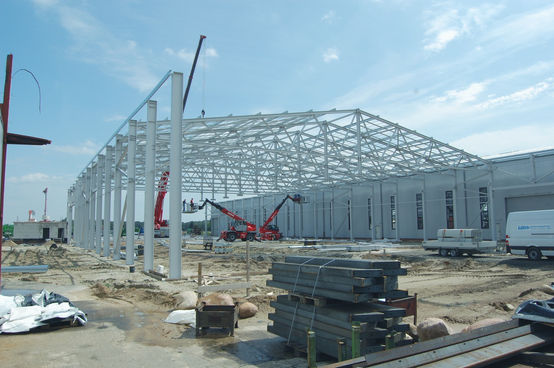
Steel construction
Create space with style
in steel construction

When it comes to steel construction, we are experts in the complete construction of steel buildings. In our modern drilling and sawing center, we can CNC-saw, drill, and mill beams up to 1,200 mm high, with any miter. We obtain the necessary data from our design department, which uses modern 3D design software.
Overhead cranes, die bending machines, sheet metal shears, and CNC-controlled drilling machines complete our professional production process.
We are certified according to DIN 1090 and are therefore able to manufacture complex and large welded structures within the scope of building regulations.
Planning Manufacturing Assembly
.
.
Lüers Maschinen- und Stahlbau GmbH goes beyond conventional notions of metalworking. We are designers, visionaries, and your partners on the path to success. Contact us and let's transform your ideas into metal and innovation together – from planning to production and assembly.

Steel hall construction
Steel construction and hall construction are two key areas of the construction industry that are gaining importance in various industries worldwide due to their versatility and robustness. These structures not only provide a solid infrastructure but also offer scope for creative solutions and innovations.
The basics and innovations
The basis of strength
Steel construction forms the backbone of many modern buildings. Steel is characterized by its exceptional strength and durability, making it ideal for load-bearing structures such as bridges, skyscrapers, and industrial facilities. A key feature of steel construction is the ability to span large distances without relying on massive support columns. This creates a distinctive architectural space and opens up a wide range of design possibilities.
Choosing the right steel is crucial, as different alloys are used depending on the requirements for strength, corrosion resistance, and price. Steel construction has evolved to meet the needs of modern society by offering resource-efficient, sustainable, and environmentally friendly solutions. One of these innovations is the use of high-strength steel, which allows for material savings while still ensuring the required stability.
Versatility and adaptability
Hall construction is an integral part of the industrial landscape. From warehouses to production facilities, from sports arenas to exhibition halls, halls serve a variety of purposes. Hall construction is characterized by its flexibility, as it can be adapted to different requirements and functions.
A notable feature of hall construction is the ability to create large open spaces. This allows companies to organize their operations efficiently and make optimal use of available space. Modern hall designs also consider energy efficiency and utilize sustainable materials and technologies to minimize the ecological footprint.
Innovations in steel and hall construction
The constant development of technologies and materials has revolutionized steel and warehouse construction. One significant innovation is the introduction of prefabricated steel frames and structures, which significantly shorten construction times and reduce overall costs. This allows companies to go live faster while building more economically.
In addition, digital technologies are playing an increasingly important role in the construction process. BIM (Building Information Modeling) enables planners, architects, and engineers to create 3D models and simulate the entire life cycle of a building. This improves planning accuracy and minimizes potential construction errors.
In terms of sustainability, steel and hall construction has increasingly shifted toward environmentally friendly practices. Recycled steel and sustainable building materials are increasingly being used to reduce the ecological impact. Solar panels, intelligent energy management systems, and green roofs are other innovations that increase the energy efficiency of halls and minimize environmental impact.
Conclusion
Steel construction and warehouse construction are two key pillars of the modern construction industry. They offer not only strength and versatility but also scope for continuous innovation. Through the use of new materials, technologies, and sustainable practices, they remain key players in shaping our built environment and helping to create a sustainable future. From impressive skyscrapers to efficient warehouses, steel and warehouse structures will continue to influence the way we live, work, and shape our world.


















